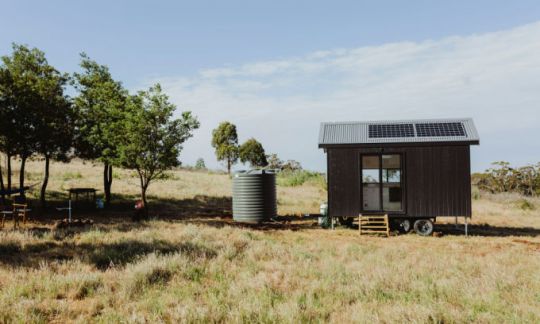How much does a tiny house cost in Australia?
When it comes to our houses, Aussies often like to think big, but the small living movement is growing. If you’re looking to start small, or even downsize your current home, you may well be wondering – how much does a tiny house cost?

When it comes to our houses, Aussies often like to think big, but the small living movement is growing. If you’re looking to start small, or even downsize your current home, you may well be wondering – how much does a tiny house cost?
What is a tiny house?
According to the Australian Tiny House Association, a tiny house is a moveable dwelling of up to 50m2 in size, suitable for permanent residential use. It has self-contained services and amenities and the option to be connected to the grid.
A tiny house can fall into one of several categories:
- A tiny house ‘on skids’ is a structure that has the ability to be moved.
- A tiny house ‘on wheels’ is a structure that is constructed on a trailer that can be towed on the road.
- Tiny houses can also be constructed out of shipping containers.
A tiny house is considered to be a different category to a ‘granny flat’, which typically refers to a fixed structure built on the same piece of land as an existing house.
How much does a tiny house cost?
A tiny house can be a practical and affordable living solution. It can even be portable and go with you wherever you go. If you’re contemplating tiny house life, then you may be wondering about the prices involved.
The cost of a tiny house can vary depending on a number of factors, but in general, you might expect them to cost anywhere from $59,000 to $150,000. The variation in cost can depend on the design and the specs – how luxurious a fit-out you choose, and whether you choose to build the dwelling yourself or buy it prefabricated.
If you opt for the DIY approach and put your house together yourself, then Aussie Tiny Houses says that building a dwelling with recycled materials could cost as little as $20,000. They caution, however, that doing this will take good project management and construction skills, and could take a long time.
Compare Personal Loans with Canstar
The table below displays some of our referral partners’ unsecured personal loan products for a three-year loan of $20,000 in NSW. The products are sorted by Star Rating (highest to lowest) followed by comparison rate (lowest to highest). Consider the Target Market Determination (TMD) before making a purchase decision. Contact the product issuer directly for a copy of the TMD. Use Canstar’s Personal Loans comparison selector to view a wider range of products on Canstar’s database. Canstar may earn a fee for referrals. Read the Comparison Rate Warning.
-
Additional repayments
-
Redraw facility
-
Top-up facility
-
Application fee: $0
-
Annualised fee: $0
-
Loan terms available: 3 years
-
Additional repayments
-
Redraw facility
-
Top-up facility
-
Application fee: $0
-
Annualised fee: $0
-
Loan terms available: 1 year to 7 years
-
Additional repayments
-
Redraw facility
-
Top-up facility
-
Application fee: $0
-
Annualised fee: $0
-
Loan terms available: 3 years to 7 years
-
Additional repayments
-
Redraw facility
-
Top-up facility
-
Application fee: $0
-
Annualised fee: $0
-
Loan terms available: 1 year to 7 years
-
Additional repayments
-
Redraw facility
-
Top-up facility
-
Application fee: $300 up to $1200
-
Annualised fee: $0
-
Loan terms available: 1 year to 7 years
The Car and/or Personal loan products displayed above that are not “Sponsored or Promoted” are sorted as referenced in the introductory text and then alphabetically by company. Canstar may receive a fee for referral of leads from these products. See How We Get Paid for further information.
Canstar is an information provider and in giving you product information Canstar is not making any suggestion or recommendation about a particular product. If you decide to apply for a personal loan, you will deal directly with a financial institution, not with Canstar. Current rates and fees are displayed and may be different to what was rated. Rates and product information should be confirmed with the relevant financial institution. For more information, read our detailed disclosure, important notes and additional information.
*Read the comparison rate warning. The results do not include all providers and may not compare all the features available to you.
Do tiny houses come pre-built?
Your tiny house may or may not come pre-built depending on who you buy it from. Some companies include the cost of assembly and delivery in their pricing, whilst others may only deliver the materials required to build your tiny house, but leave the assembly to you.
If your tiny house comes as materials only, then you could choose to build the house yourself, or pay a builder to do it for you. Whatever approach you take, you’ll need to make sure your tiny house complies with the relevant building and safety standards in your area.
What other tiny house costs will you need to consider?
In addition to the cost of purchasing a tiny house, you will need to consider the costs of keeping it running and powered, especially if you plan on living off grid. Some important extra costs to consider include:
- Electricity (solar power systems)
- Generators
- Composting toilets
- Water storage tanks
- Grey water systems
- Grease trap systems
If you plan to live off grid in a tiny house, then it is important to think about your energy consumption habits, and possibly reduce some of them. High energy-consumption appliances like air conditioning systems, electric kettles and toasters, cooktops and ovens may need to be used sparingly or substituted for energy-efficient alternatives.
Can you get a home loan for a tiny house?
If you’re curious about how much a tiny house costs, you may also be thinking about how to finance the purchase. Given that tiny houses tend to be portable, you may find that obtaining a traditional home loan for a tiny house is not possible or is more difficult than usual.
According to online home loan lenders Lendi, a home must be fixed and not portable in order to obtain bank finance, which could rule out many tiny houses. While this may rule out a home loan, there are other potential options for finance on the table, including:
- Using equity from your land. If you already own the land that you plan to put your tiny house on, you could access equity from this, or from an existing property you own, to finance the purchase.
- Taking out a personal loan. You may choose to apply for a personal loan to finance the purchase of a tiny house. It’s important to be aware that personal loan terms tend to be shorter than home loan terms – typically lasting up to seven years – and interest rates tend to be higher. A personal loan can be secured or unsecured and understanding the difference is also important when it comes to the cost of the loan.
- Taking out a motorhome loan. A motorhome loan could be an option for finance if your tiny house is on wheels and meets all relevant regulatory and safety standards. For this kind of loan, you will typically be required to pay a deposit, and the term of the loan may be between 10 and 15 years.
-
Additional repayments
-
Redraw facility
-
Top-up facility
-
Application fee: $0
-
Annualised fee: $0
-
Loan terms available: 1 year to 7 years
-
Additional repayments
-
Redraw facility
-
Top-up facility
-
Application fee: $0
-
Annualised fee: $0
-
Loan terms available: 5 years
-
Additional repayments
-
Redraw facility
-
Top-up facility
-
Application fee: $0
-
Annualised fee: $0
-
Loan terms available: 3 years to 7 years
Fast quote. No account required.
Won't affect your credit score. GET YOUR RATE NOW.
-
Additional repayments
-
Redraw facility
-
Top-up facility
-
Application fee: $575
-
Annualised fee: $0
-
Loan terms available: 3 years to 7 years
Canstar may earn a fee for referrals from its website tables, and from Sponsorship or Promotion of certain products. Fees payable by product providers for referrals and Sponsorship or Promotion may vary between providers, website position, and revenue model. Sponsorship or Promotion fees may be higher than referral fees. Sponsored or Promotion products are clearly disclosed as such on website pages. They may appear in a number of areas of the website such as in comparison tables, on hub pages and in articles. Sponsored or Promotion products may be displayed in a fixed position in a table, regardless of the product’s rating, price or other attributes. The table position of a Sponsored or Promoted product does not indicate any ranking or rating by Canstar. For more information please see How We Get Paid.
What are the pros and cons of tiny house living?
Pros of living in a tiny house
- Sustainability. If you choose to install solar panels and a water tank as part of your tiny house, you may end up living in a self-sufficient home. The construction of a tiny house may also generate a smaller carbon footprint than the construction of a traditional home, due to its smaller size.
- Mobility. If you enjoy going on road trips or camping holidays, a tiny house on a trailer can be taken with you. However, you may need a 4WD or similarly large vehicle in order to tow something as heavy as a tiny house.
- Lower overhead costs. If your tiny house generates most or all of its own electricity and water, your utility bills will be considerably smaller than they would be if you lived in a traditional home. You may also avoid paying council rates depending on your local council laws.
- Less cleaning up. A smaller home means less space, which in turn means that doing even the most thorough house clean will generally take considerably less time than cleaning a conventional house.
Cons of living in a tiny house
- Small size. As the name suggests, tiny houses have smaller floor plans and less living space than full-sized homes, so you will need to be prepared to live in a more intimate space, and potentially be prepared for a Marie Kondo-like cull of your belongings.
- Difficulty finding a location. Unless you have a friend or family member with a backyard that they’re happy to let you use, you’ll need to either buy or rent land to park your tiny house on. This can make what was supposedly a cheap option significantly more expensive.
- Potential for red tape. Whilst being classed as caravans allows tiny houses in Australia to avoid some of the regulatory red tape that’s associated with buying a standard home, you may still encounter issues depending on where you live. Local councils may have their own specific rules and regulations regarding tiny houses. So, consider doing your research or seeking legal advice on your options before committing.
- Self-sustainability. Whilst the potential for sustainability that comes with tiny house living may be appealing, you’ll need to make sure to secure your electricity and water supply and have a backup plan in place in case you run out.
- Fewer creature comforts. Living in a smaller house means less space for storage, but this extends to appliances that might make your life easier. Things like clothes driers, spacious fridges, and even a standard washing machine may prove impractical depending on the size of your tiny house.
- Potential for clutter. Whilst living in a smaller space can make tidying up a breeze, it also makes dirtying or cluttering your home easier too. A mess that might’ve seemed proportionately minor in a conventional home could be a bit more significant in a tiny house.
How do you insure a tiny house?
One important tiny house cost to consider is the cost of insurance. As many Australian tiny houses are built on trailers and are subsequently classified as caravans rather than houses, you may have to take out caravan insurance in order to insure your tiny house and its contents.
Your tiny home may be covered by compulsory third party (CTP) insurance while attached to and being moved by a registered vehicle, however CTP insurance will not provide cover for damage to your tiny house. It will only provide liability cover if your car or tiny house causes harm or fatal injury to others while on the road.
Cover image source: St John Imagery/Shutterstock.com
This article was reviewed by our Content Lead, Canstar Mandy Beaumont before it was updated, as part of our fact-checking process.

Alasdair Duncan is Canstar's Content Editor, specialising in home loans, property and lifestyle topics. He has written more than 500 articles for Canstar and his work is widely referenced by other publishers and media outlets, including Yahoo Finance, The New Daily, The Motley Fool and Sky News. He has featured as a guest author for property website homely.com.au.
In his more than 15 years working in the media, Alasdair has written for a broad range of publications. Before joining Canstar, he was a News Editor at Pedestrian.TV, part of Australia’s leading youth media group. His work has also appeared on ABC News, Junkee, Rolling Stone, Kotaku, the Sydney Star Observer and The Brag. He has a Bachelor of Laws (Honours) and a Bachelor of Arts with a major in Journalism from the University of Queensland.
When he is not writing about finance for Canstar, Alasdair can probably be found at the beach with his two dogs or listening to podcasts about pop music. You can follow Alasdair on LinkedIn.
The comparison rate for all home loans and loans secured against real property are based on secured credit of $150,000 and a term of 25 years.
^WARNING: This comparison rate is true only for the examples given and may not include all fees and charges. Different terms, fees or other loan amounts might result in a different comparison rate.
 Owner occupied
Owner occupied
 20% min deposit
20% min deposit
 Redraw facility
Redraw facility
Try our Home Loans comparison tool to instantly compare Canstar expert rated options.
The comparison rate for all home loans and loans secured against real property are based on secured credit of $150,000 and a term of 25 years.
^WARNING: This comparison rate is true only for the examples given and may not include all fees and charges. Different terms, fees or other loan amounts might result in a different comparison rate.











